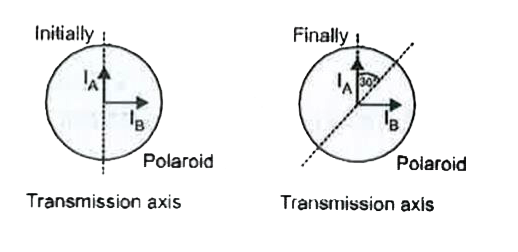Two beams, A and B, of plane polarized light with mutually perpendicular planes of polarization are seen through a polaroid. From the position when the beam A has maximum intensity (and beam B has zero intensity), a rotation of Polaroid through 30∘ makes the two beams appear equally bright.If the initial intensities of the two beams are IA and IB respectively, then IAIB equals :
13
3
32
1
The correct Answer is:A

IAcos230∘=IBcos260∘
IA34=IB14 IAIB=13
Topper's Solved these Questions
- WAVE OPTICS BOOK - MODERN PUBLICATIONCHAPTER - WAVE OPTICS EXERCISE - Recent Competitive Questions
18 Videos
- WAVE OPTICS BOOK - MODERN PUBLICATIONCHAPTER - WAVE OPTICS EXERCISE - MCQ LEVEL- II (PARAGRAPH QUESTIONS)
28 Videos
- WAVE MOTIONBOOK - MODERN PUBLICATIONCHAPTER - WAVE MOTIONEXERCISE - RECENT COMPETITIVE QUESTIONS
18 Videos
- WORK , POWER , ENERGY AND COLLISIONSBOOK - MODERN PUBLICATIONCHAPTER - WORK , POWER , ENERGY AND COLLISIONSEXERCISE - Revision Test
40 Videos
Similar Questions
Two beams A and B, of plane polarized light with mutually perpendicular planes of polarization are seen through a polaroid. From the position when the beam a has maximum intensity (and beam B has zero ntensity), a rotation of polaroid through 30∘ makes the two beams appear equally bright. If the initial intensities of the two beams are IA and IB respectively, then IAIB equals:
View SolutionA beam of unpolarised light of intensity I0 is passed through a polaroid and then through another polaroid B which is oriented so that its principal plane makes an angle of 45∘ relative to that of A. The intensity of the emergent light is
View Solution
Knowledge Check
Two beams A and B, of plane polarized light with mutually perpendicular planes of polarization are seen through a polaroid. From the position when the beam a has maximum intensity (and beam B has zero ntensity), a rotation of polaroid through 30∘ makes the two beams appear equally bright. If the initial intensities of the two beams are IA and IB respectively, then IAIB equals:
A3B32C1D13Two beams A and B, of plane polarized light with mutually perpedicular planes of polarization are seen through a polaroid. From the position where the beam A has maximum intensity and the other beam B has zero intensity , the polaroid is rotated through 30∘ making the two beams appear equally bright. If the initial intensities of the two beams are IA and IB0 respectively, then IAIB equals
A2B3/2C1D1/3Two beams, A and B, of plane polarised light with mutually perpendicular planes of polarisation are seen through a polarised light with mutually perpendicular planes of polarisation are seen through a polaroid. From the position when the beam A has maximum intensity (and beam B has zero intensity). a rotation of Polaroid through 30∘ makes the two beams appear equally bright. If the intiial intensities of the two beams are IAandIB respectively, then IA/IB equals :
A1/3B3C3/2D1
A plane polarized light with intensity I0 is incident on a polaroid with Electric Field vector making an angle of 60∘ with transmission axis of polaroid. The intensity of the resulting light will be
View SolutionA plane polarized light with intensity I0 is incident on a polaroid with Electric Field vector making an angle of 60∘ with transmission axis of polaroid. The intensity of the resulting light will be
View SolutionAs polaroid examines two adjacent plane polarised beam A and B whose planes of polarisation are mutually perpendicular. In the first position of the analyser, beam B shows zero intensity. From this position a rotation 30∘ shows that thebeams have same intensity. The ratio of intensity of the two beam IZ&IB
View SolutionA beam of unpolarised light of intensity I0 is passed through a polaroidA and then through another polaroid B which is oriented so that its principal plane makes an angle of 45∘ relative to that of A. The intensity of the emergent light is
View SolutionAn unpolarized beam of light of intensity I0 passes through two linear polarizers making an angle of 30∘ with respect to each other. The emergent beam will have an intensity –
View Solution
